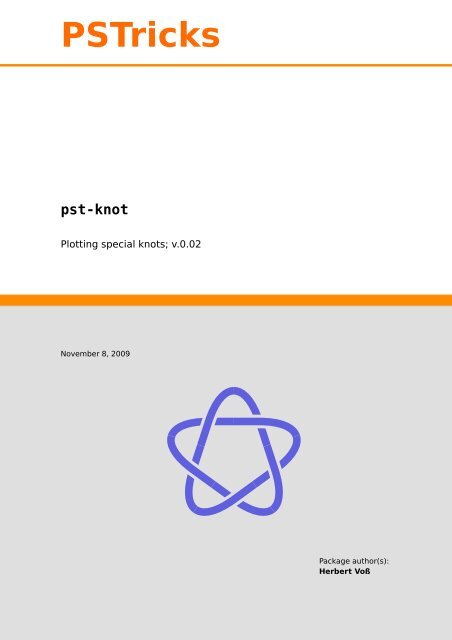PSTricks pst-knot - CTAN
PSTricks pst-knot - CTAN
PSTricks pst-knot - CTAN
- No tags were found...
Create successful ePaper yourself
Turn your PDF publications into a flip-book with our unique Google optimized e-Paper software.
<strong>PSTricks</strong><br />
<strong>pst</strong>-<strong>knot</strong><br />
Plotting special <strong>knot</strong>s; v.0.02<br />
November 8, 2009<br />
Package author(s):<br />
Herbert Voß
Contents 2<br />
Contents<br />
1 introduction 2<br />
2 \psKnot 2<br />
3 Special settings 4<br />
3.1 Scaling . . . . . . . . . . . . . . . . . . . . . . . . . . . . . . . . . . . . . . 5<br />
3.2 Border color . . . . . . . . . . . . . . . . . . . . . . . . . . . . . . . . . . . 5<br />
3.3 Border width . . . . . . . . . . . . . . . . . . . . . . . . . . . . . . . . . . 6<br />
4 \psBorromean 6<br />
5 List of all optional arguments for <strong>pst</strong>-<strong>knot</strong> 7<br />
References 7<br />
1 introduction<br />
Thisis thevery firsttry of drawing<strong>knot</strong>s. Thepackage usesthePostScript subroutines<br />
of the file psMath.pro from Matthias Buch-Kromann.) Currently there are only<br />
two macros for <strong>knot</strong>s.<br />
2 \psKnot<br />
The macro \psKnot has one optional and two mandatory arguments, the origin of the<br />
image and the <strong>knot</strong> type. The following list shows all available <strong>knot</strong> types.<br />
\psKnot [Options] (x,y){<strong>knot</strong> type}<br />
2<br />
1<br />
0<br />
-1<br />
-2<br />
-2 -1 0 1 2<br />
1\begin{pspicture}[showgrid=true](-2,-2)(2,2)<br />
2 \psKnot[linewidth=3pt,linecolor=red](0,0){0-1}<br />
3\end{pspicture}
2 \psKnot 3<br />
2<br />
1<br />
0<br />
-1<br />
-2<br />
-2 -1 0 1 2 3 4 5 6 7 8<br />
1\begin{pspicture}[showgrid=true](-2,-2)(8,2)<br />
2 \psKnot[linewidth=3pt,linecolor=red](0,0){3-1}<br />
3 \psKnot[linewidth=3pt,linecolor=blue](4,0){4-1}<br />
4\end{pspicture}<br />
1\begin{pspicture}(-2,-2)(8,2)<br />
2 \psKnot[linewidth=3pt,linecolor=blue](0,0){5-1}<br />
3 \psKnot[linewidth=3pt,linecolor=blue](4,0){5-2}<br />
4\end{pspicture}<br />
1\begin{pspicture}(-2,-2)(10,2)<br />
2 \psKnot[linewidth=3pt,linecolor=blue](0,0){6-1}<br />
3 \psKnot[linewidth=3pt,linecolor=blue](4,0){6-2}<br />
4 \psKnot[linewidth=3pt,linecolor=blue](8,0){6-3}<br />
5\end{pspicture}
3 Specialsettings 4<br />
1\begin{pspicture}(-2,-2)(10,2)<br />
2 \psKnot[linewidth=3pt,linecolor=red](0,0){7-1}<br />
3 \psKnot[linewidth=3pt,linecolor=blue](4,0){7-2}<br />
4 \psKnot[linewidth=3pt,linecolor=green](8,0){7-3}<br />
5\end{pspicture}<br />
1\begin{pspicture}(-2,-2)(10,2)<br />
2 \psKnot[linewidth=3pt,linecolor=red](0,0){7-4}<br />
3 \psKnot[linewidth=3pt,linecolor=green](4,0){7-5}<br />
4 \psKnot[linewidth=3pt,linecolor=blue](8,0){7-6}<br />
5\end{pspicture}<br />
2<br />
1<br />
0<br />
-1<br />
-2<br />
-2 -1 0 1 2<br />
1\begin{pspicture}[showgrid=true](-2,-2)(2,2)<br />
2 \psKnot[linewidth=3pt,linecolor=blue](0,0){7-7}<br />
3\end{pspicture}<br />
3 Special settings<br />
There exists three special optional arguments for the macro \psKnot.
3.1 Scaling 5<br />
3.1 Scaling<br />
The image can be scaled with scale, which can take one or two values for x and y<br />
scaling. For only one value it is scaled for x and y with the same value. The default is<br />
1 1.<br />
1\begin{pspicture}(-4,-4)(4,4)<br />
2 \psKnot[linewidth=5pt,linecolor=blue,<strong>knot</strong>scale=2](0,0){6-1}<br />
3\end{pspicture}<br />
3.2 Border color<br />
Thebackgroundcolor of the border canbe controlled by <strong>knot</strong>bgcolor. Itcanuseany<br />
possible colorvalueanditmakesonlysenseforacoloredbackgroundtogetthesame<br />
color for the crossing.<br />
1\begin{pspicture}(-2,-2)(6,2)<br />
2 \psframe[fillcolor=black!20,fillstyle=solid](-2,-2)(6,2)<br />
3 \psKnot[linewidth=5pt,linecolor=red!50](0,0){7-4}<br />
4 \psKnot[linewidth=5pt,linecolor=red!50,<br />
5 <strong>knot</strong>bgcolor=black!20](4,0){7-4}<br />
6\end{pspicture}<br />
Pay attention that black!20 is the same as 0,8 of gray.
3.3 Borderwidth 6<br />
3.3 Border width<br />
The width of the border is controlled by the keyword <strong>knot</strong>border and it is preset to<br />
5\pslinewidth. The border width is added to the current linewidth.<br />
1\begin{pspicture}(-2,-2)(6,2)<br />
2 \psKnot[linewidth=3pt,linecolor=cyan!60](0,0){6-3}<br />
3 \psKnot[linewidth=3pt,linecolor=red!50,<br />
4 <strong>knot</strong>border=5\pslinewidth](4,0){6-3}<br />
5\end{pspicture}<br />
4 \psBorromean<br />
The macro \psBorromean draws the so called Borromean rings. It has one optional<br />
and three mandatory arguments, the origin of the image, the inner and outer radius.<br />
The following list shows all available <strong>knot</strong> types.<br />
\psBorromean [Options] (x,y){circle radius}{inner radius}<br />
4<br />
3<br />
2<br />
1<br />
0<br />
-1<br />
-2<br />
-3<br />
-2 -1 0 1 2 3 4 5 6 7 8 9 10<br />
1\begin{pspicture}[showgrid=true](-2,-3)(10,4)<br />
2 \psBorromean(0,0){1cm}{1cm}<br />
3 \psBorromean[linewidth=8pt,<strong>knot</strong>border=2\pslinewidth,<br />
4 bmcolor={blue,yellow,magenta}](6,0){2cm}{1.5cm}<br />
5\end{pspicture}
References 7<br />
5 List of all optional arguments for <strong>pst</strong>-<strong>knot</strong><br />
Key Type Default<br />
<strong>knot</strong>border ordinary 2<br />
<strong>knot</strong>bgcolor ordinary 1<br />
<strong>knot</strong>scale ordinary 1 1<br />
bmcolor ordinary [none]<br />
References<br />
[1] Denis Girou. Présentation de <strong>PSTricks</strong>. Cahier GUTenberg, 16:21–70, April<br />
1994.<br />
[2] Michel Goosens, Frank Mittelbach, Sebastian Rahtz, Denis Roegel, and Herbert<br />
Voß. The L A T E X Graphics Companion. Addison-Wesley Publishing Company,<br />
Reading, Mass., 2 edition, 2007.<br />
[3] Laura E. Jacksonand Herbert Voß. Die Plot-Funktionen von <strong>pst</strong>-plot. Die<br />
T E Xnische Komödie, 2/02:27–34, June 2002.<br />
[4] Nikolai G. Kollock. PostScript richtig eingesetzt: vom Konzept zum praktischen<br />
Einsatz. IWT, Vaterstetten, 1989.<br />
[5] Herbert Voß. Die mathematischenFunktionen von PostScript. Die T E Xnische<br />
Komödie, 1/02, March 2002.<br />
[6] Herbert Voß. L A T E X Referenz. DANTE–Lehmanns, Heidelberg/Hamburg, 1.<br />
edition, 2007.<br />
[7] Herbert Voß. <strong>PSTricks</strong> – Grafik für T E X und L A T E X. DANTE – Lehmanns,<br />
Heidelberg/Hamburg, 4. edition, 2007.<br />
[8] Timothy van Zandt. <strong>PSTricks</strong> - PostScript macros for generic T E X. http://<br />
www.tug.org/application/<strong>PSTricks</strong>, 1993.<br />
[9] Timothy van Zandt. multido.tex - a loop macro, that supports fixed-point<br />
addition. <strong>CTAN</strong>:/graphics/<strong>pst</strong>ricks/generic/multido.tex, 1997.<br />
[10] Timothy van Zandt. <strong>pst</strong>-plot: Plotting two dimensional functions and data.<br />
<strong>CTAN</strong>:graphics/<strong>pst</strong>ricks/generic/<strong>pst</strong>-plot.tex, 1999.<br />
[11] Timothy van Zandt and Denis Girou. Inside <strong>PSTricks</strong>. TUGboat, 15:239–246,<br />
September 1994.
Index<br />
Dimension<br />
\pslinewidth, 6<br />
File<br />
psMath.pro, 2<br />
Keyword<br />
<strong>knot</strong>bgcolor, 5<br />
<strong>knot</strong>border, 6<br />
scale, 5<br />
<strong>knot</strong>bgcolor, 5<br />
<strong>knot</strong>border, 6<br />
Macro<br />
\psBorromean, 6<br />
\psKnot, 2, 4<br />
\psBorromean, 6<br />
\psKnot, 2, 4<br />
\pslinewidth, 6<br />
psMath.pro, 2<br />
scale, 5<br />
8

















